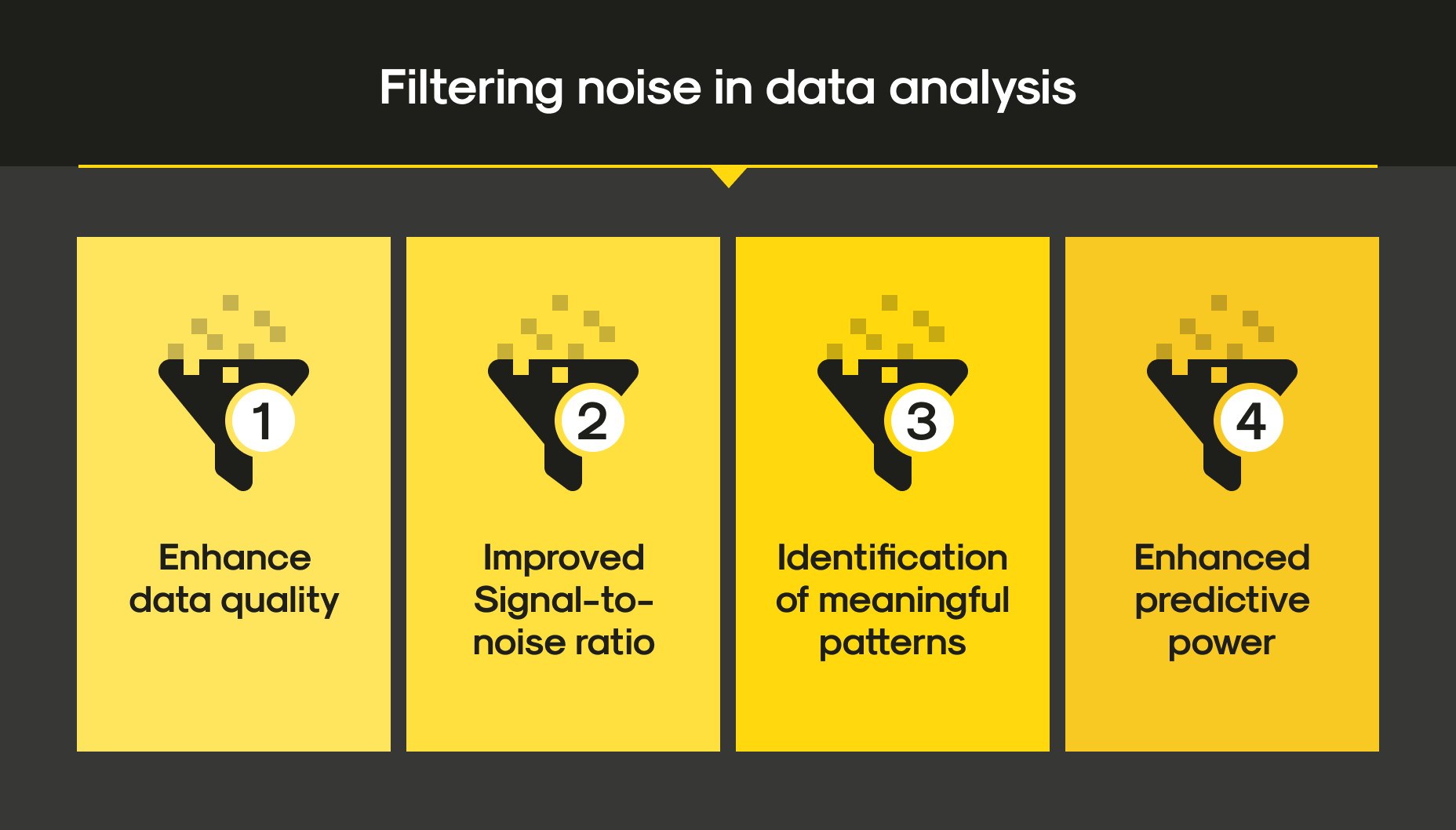Businesses don’t face a shortage of data. Instead, they face an overwhelming surplus. Dashboards blink with real-time updates, logs pile up by the terabyte, and customer feedback flows in from every digital channel. The age-old problem has flipped: the challenge is no longer collecting data, but making sense of it. And when the noise drowns out the signal, businesses find themselves sort of paralyzed.
This phenomenon, known as signal-to-noise collapse, describes a situation where useful information is buried beneath layers of irrelevant, outdated, or conflicting data. As of today, it’s a serious obstacle to decision-making, execution, and innovation.
So what’s the solution? Enter AI systems that do more than just analyze: they prioritize, contextualize, and adapt. In this article, you’ll discover:
- What signal-to-noise collapse is and why it’s crippling decision-making in data-rich environments
- How traditional analytics tools fall short in filtering relevant insights
- How AI systems act as signal amplifiers through context, personalization, and intelligent prioritization
- Real-world examples of how AI filters noise in healthcare, retail, and finance
- A practical checklist for building AI that enhances clarity instead of adding confusion
- How Mitrix helps companies design AI tools that cut through noise and surface what matters most

Filtering noise in data analysis
From information overload to decision paralysis
The phrase “signal-to-noise ratio” comes from engineering, where it refers to the amount of useful data (signal) relative to irrelevant data (noise). The higher the ratio, the easier it is to extract meaningful patterns. In today’s digital environments, that ratio is collapsing.
Modern businesses across industries often have:
- Hundreds of KPIs tracked simultaneously
- Disconnected data sources across departments
- Dozens of dashboards, alerts, and reports updated in real-time
- Mountains of unstructured data: emails, chats, PDFs, logs
Ironically, the more data we gather, the harder it becomes to use. Decision-makers either rely on outdated gut instincts or spend so long sifting through inputs that momentum stalls. We’ve created a world where data is everywhere, but insight is nowhere.
Why traditional tools fail to filter
As a matter of fact, conventional analytics platforms were designed for structured data, static reports, and linear workflows. They weren’t built to handle:
- Velocity. Real-time data streams updating every second
- Volume. Petabytes of data flowing across departments
- Variety. Structured vs. unstructured, visual vs. text, quantitative vs. qualitative
- Volatility. Metrics that change meaning based on shifting market or operational contexts
This complexity overwhelms not just humans, but the dashboards and filters they depend on. Even the best BI tools end up surfacing too much information without knowing what’s truly relevant at any given time. A sea of pie charts won’t save you when the signal is hiding in the margins.
Limitations
Human cognition is ill-equipped to handle the scale and complexity of modern data environments. Despite our strengths in intuition and pattern recognition, we are inherently limited when faced with large, multidimensional datasets. Cognitive biases (such as anchoring, recency bias, or confirmation bias) frequently distort our decision-making. More importantly, we often fail to detect faint but meaningful patterns obscured by overwhelming volumes of irrelevant information.
Consider a few common scenarios:
- A department head might focus narrowly on a single declining KPI while missing a broader trend of organizational growth.
- A sales team may rely on selective anecdotal feedback, overlooking aggregate insights derived from customer behavior across touchpoints.
- A risk analyst might dismiss early indicators of systemic issues because the signals emerge in low-frequency, outlier events that are easy to ignore without computational support.
These limitations are not signs of negligence. In fact, they’re natural consequences of working memory constraints and limited bandwidth for synthesis. In an age where data volume grows exponentially, the need for augmentation is clear. This is precisely where artificial intelligence proves invaluable: not by replacing human judgment, but by enhancing it, amplifying signals, suppressing noise, and surfacing insights that would otherwise remain hidden.
Enter AI: from analyst to signal amplifier
As of today, modern AI systems are context engines. They don’t just highlight trends, but learn what matters to a user, a role, or a decision. They distinguish noise from signal dynamically and adjust their behavior as the situation evolves.
Here’s how AI restores clarity in a world full of noise:
1. Contextual prioritization
AI doesn’t treat all data as equal. Through user profiling and intent detection, modern systems understand what a marketing lead wants to see versus what a compliance officer cares about. This personalization reduces cognitive load and highlights the most relevant signals for each user.
2. Anomaly detection that understands meaning
Old systems raise alarms every time a metric spikes. AI, on the other hand, learns what constitutes “normal” for a given time, region, or context, and flags only what’s truly out of bounds.
3. Semantic understanding of unstructured data
By using NLP (Natural Language Processing), AI can extract insights from customer feedback, support chats, and internal documents, things that used to live outside the dashboard. That “hidden” signal becomes visible and actionable.
4. Narrative intelligence
AI copilots can explain what’s happening in plain language: “Revenue is down 12% in Region B due to a spike in churn among SMB accounts.” You don’t just get data, you get the story behind the data, complete with suggested actions.
Real-world examples of signal filtering in action
Healthcare
Instead of overwhelming doctors with hundreds of metrics, AI-powered dashboards highlight anomalies tied to specific diagnoses or risk profiles, surfacing what might be early signs of complications.
Retail
Dynamic pricing systems use AI to detect weak buying signals and optimize promotions in real time. Noise like social media buzz or competitor discounts gets filtered into relevant strategy changes.
Finance
Fraud detection AI isolates signal patterns from billions of normal transactions and catches fraud not by rigid rules, but through adaptive pattern recognition across time and geography.
Challenges still ahead
Even AI systems aren’t immune to noise. In fact, poor training data or badly designed feedback loops can introduce new noise into the system. There’s also the risk of AI hiding meaningful weak signals because they don’t match past patterns.
Some major challenges include:
- Bias in signal selection. AI systems may reinforce historical patterns, missing disruptive trends.
- Loss of human oversight. If users blindly trust AI-generated signals, critical thinking erodes.
- Context collapse. If the system doesn’t retain enough memory or personalization, it reintroduces noise.
The solution is to design AI systems with transparency, robust feedback loops, and adaptive memory that can evolve with changing user needs, maintain context across interactions, and continuously refine what counts as signal. This practice will ensure that what’s surfaced is not only accurate, but also relevant, timely, and aligned with real-world goals.
Designing AI systems that get it right
If your system can’t distinguish signals from distraction, every recommendation, alert, or insight becomes suspect. To stay competitive, businesses must adopt AI architectures that are not only intelligent but also intentional.
That means designing systems that understand what matters, when it matters, and to whom. This concept requires embedding clarity into every layer of the stack, from data ingestion to user interface.
- Clear signal definitions. Know what outcomes you want, and teach the system to prioritize those.
- Grounding in real-time data. Use retrieval-augmented generation (RAG) to connect AI to fresh, trusted sources.
- Session-aware context. Retain user history across sessions to personalize signal detection.
- Explainability built-in. Let users challenge or investigate how a recommendation was made.
- Multi-agent systems. Delegate signal filtering, memory management, and output generation to specialized AI components working in concert.
How Mitrix can help
At Mitrix, we offer AI/ML and generative AI development services to help businesses move faster, work smarter, and deliver more value. We help businesses go beyond proof-of-concept AI. We focus on building AI solutions that aren’t just viable, they’re valuable, trusted, and adopted.
Our team builds AI systems that turn data into clarity. Whether you’re drowning in operational metrics or struggling to extract insights from user behavior, we design AI solutions that filter out the noise and surface what really matters.
Our approach includes:
- Custom signal-detection pipelines tailored to your KPIs and operational goals
- LLM-powered insight layers that translate complexity into clear narratives
- Real-time memory systems that keep AI aligned with evolving context
- Feedback loops and human-in-the-loop design to ensure trust and accuracy
We don’t just build models. We build decision support systems that work in the wild, where data is messy, time is short, and every signal counts. Let’s talk!
Wrapping up
More dashboards, more alerts, more data – that’s not progress, that’s digital noise, if you will. The future of AI lies not in delivering more information, but in delivering the right information at the right time. Modern AI tools make it easier than ever to identify and eliminate potential time traps.
Because when signal-to-noise collapses, so do trust, speed, and competitiveness. But when AI systems are built to filter, prioritize, and adapt, you regain clarity and control. Your decisions get sharper, actions more timely, and teams move with confidence.


